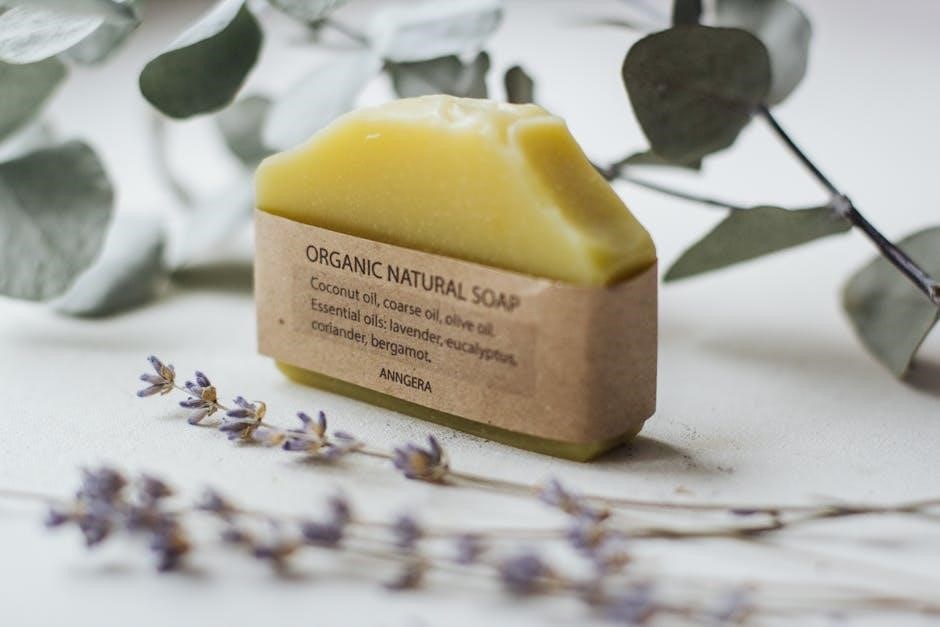
Essential Oil List and Uses PDF: A Comprehensive Guide
Unlock the secrets of aromatherapy with our comprehensive guide to essential oils! This resource offers a detailed exploration of various essential oils, their unique properties, and diverse applications for health, wellness, and home care. Downloadable in PDF format, this chart is a must-have for enthusiasts.
Essential oils are concentrated plant extracts that retain the natural smell and flavor, or “essence,” of their source. Extracted through various methods like distillation or cold pressing, these oils have gained immense popularity for their therapeutic properties and versatile applications.
Aromatherapy, the practice of using essential oils for therapeutic benefit, has been around for centuries. The aromatic compounds in essential oils can affect mood, reduce stress, and promote relaxation. Beyond aromatherapy, essential oils are used in skincare, haircare, cleaning products, and even culinary applications.
Understanding the basics of essential oils, including their extraction methods, chemical composition, and potential benefits, is crucial before incorporating them into your daily routine. Knowing how to safely dilute and apply essential oils is essential to avoid adverse reactions. This guide will provide the fundamental knowledge you need to start your journey with essential oils confidently.
Whether you’re seeking natural remedies, ways to enhance your well-being, or eco-friendly alternatives for household products, essential oils offer a wide array of possibilities. Explore the world of essential oils and discover how they can positively impact your life.
Benefits of Using Essential Oil Lists and Uses PDFs
Essential oil lists and uses PDFs serve as invaluable resources for both beginners and experienced users of essential oils. These comprehensive guides offer a wealth of information, neatly organized and easily accessible, empowering individuals to make informed decisions about their essential oil practices.
One of the primary benefits is convenience. Having a readily available PDF allows for quick reference, whether you’re at home, traveling, or shopping for essential oils. The lists typically include detailed information on each oil’s properties, aroma, blending suggestions, and potential therapeutic benefits. This saves time and effort compared to searching for information online from various sources.
These PDFs often provide safety guidelines, dilution ratios, and precautions, ensuring users handle essential oils responsibly and avoid potential adverse reactions. They can also include information on carrier oils, which are crucial for diluting essential oils before topical application.
Moreover, essential oil lists and uses PDFs can inspire creativity by suggesting blends for specific purposes, such as relaxation, energy boost, or immune support. They may also feature DIY recipes for skincare, haircare, and household cleaning products, encouraging a more natural and sustainable lifestyle.
In essence, these PDFs act as a user-friendly encyclopedia, equipping individuals with the knowledge to confidently and safely explore the diverse world of essential oils.
Popular Essential Oils and Their Uses
Essential oils have surged in popularity, and certain oils have become staples due to their versatility and effectiveness. Lavender, renowned for its calming properties, is widely used to promote relaxation, improve sleep, and soothe skin irritations. Lemon essential oil, with its invigorating citrus scent, is a favorite for boosting mood, cleansing surfaces, and supporting the immune system.
Peppermint oil is another popular choice, known for its energizing aroma and ability to relieve headaches and digestive issues. Tea tree oil, with its potent antiseptic properties, is commonly used to treat acne, fungal infections, and insect bites.
Eucalyptus oil is prized for its decongestant properties, making it ideal for relieving coughs, colds, and sinus congestion. Frankincense oil, revered for its grounding aroma and skin-rejuvenating benefits, is often used in meditation and skincare routines.
Other notable essential oils include rosemary for memory and hair growth, chamomile for relaxation and skin soothing, and cedarwood for its grounding and calming effects.
These popular essential oils offer a wide range of benefits and can be incorporated into various aspects of daily life, from aromatherapy and skincare to household cleaning and natural remedies. Understanding their individual properties and uses empowers individuals to harness their therapeutic potential effectively.

Essential Oil Dilution Chart
Essential oils are highly concentrated and potent substances, necessitating dilution before topical application to prevent skin irritation or adverse reactions. An essential oil dilution chart serves as a crucial guide, providing precise ratios of essential oil to carrier oil for safe and effective use.
The dilution chart typically outlines different dilution percentages, ranging from 0.5% to 5%, each suited for specific applications and age groups. For instance, a 0.5% dilution is generally recommended for infants and young children, while a 1% dilution is appropriate for the elderly and individuals with sensitive skin.
Adults can typically tolerate dilutions ranging from 2% to 3% for general use, such as massage oils and daily skincare. Higher dilutions, such as 5%, are reserved for targeted treatments like muscle pain relief or wound care, and should be used with caution and for limited periods.
Carrier oils, such as almond oil, coconut oil, jojoba oil, or grapeseed oil, play a vital role in diluting essential oils, reducing their concentration, and facilitating absorption into the skin. The choice of carrier oil can also enhance the therapeutic benefits of the blend, depending on its own unique properties.
By consulting an essential oil dilution chart, users can ensure that they are using essential oils safely and effectively, maximizing their therapeutic potential while minimizing the risk of adverse reactions.
Carrier Oils for Essential Oils
Carrier oils are vegetable oils used to dilute essential oils before topical application. Essential oils are potent and can cause skin irritation if applied undiluted. Carrier oils help to reduce the concentration of essential oils, making them safe for use on the skin.
Choosing the right carrier oil is important, as each oil has its own unique properties and benefits. Some popular carrier oils include:

- Sweet Almond Oil: A versatile oil suitable for most skin types. It is easily absorbed and leaves the skin feeling soft and smooth.
- Coconut Oil: A moisturizing oil with antibacterial and antifungal properties. Fractionated coconut oil is a good option as it remains liquid at room temperature.
- Jojoba Oil: Closely resembles the skin’s natural sebum, making it easily absorbed and suitable for all skin types.
- Grapeseed Oil: A light and non-greasy oil that is rich in antioxidants.
- Avocado Oil: A rich and moisturizing oil that is particularly beneficial for dry or mature skin.

When selecting a carrier oil, consider your skin type, the intended use of the essential oil blend, and any allergies or sensitivities you may have. Always perform a patch test before using a new carrier oil or essential oil blend to ensure that you do not experience any adverse reactions.
Safety Precautions When Using Essential Oils
Essential oils are potent natural substances that require careful handling. Prioritize safety to avoid adverse reactions. Dilution is paramount; always dilute essential oils with a carrier oil before applying to the skin. A general guideline is 1-3% dilution for adults, adjusting lower for children and sensitive individuals.
Perform a patch test before widespread use. Apply a small, diluted amount to an area like the inner arm and observe for 24-48 hours for any irritation. Avoid contact with eyes and mucous membranes; if contact occurs, flush immediately with a carrier oil, not water.
Some oils are photosensitive, meaning they can increase skin sensitivity to sunlight. Avoid sun exposure after topical application of oils like citrus.
Certain medical conditions may contraindicate essential oil use; consult a healthcare professional if you have concerns. Keep essential oils out of reach of children and pets. Proper storage in dark, airtight containers away from heat and light is crucial to maintain potency and prevent degradation. If irritation occurs, discontinue use immediately.
Essential Oils to Avoid During Pregnancy and Breastfeeding
Pregnancy and breastfeeding require extra caution when using essential oils. Certain oils pose potential risks to both mother and child due to their chemical constituents. Avoid internal use of essential oils during these times.

Specifically, it’s recommended to steer clear of oils like clary sage, rosemary, sage, basil, jasmine, juniper berry, myrrh, and pennyroyal. These oils have emmenagogue or abortifacient properties, which can stimulate uterine contractions or affect hormonal balance, potentially leading to complications.
Additionally, use caution with anise, birch, camphor, hyssop, tansy, and wintergreen. Always consult with a qualified aromatherapist or healthcare provider before using any essential oils during pregnancy or breastfeeding to ensure safety.
Even seemingly mild oils should be used sparingly and with proper dilution. Individual reactions can vary, so monitoring for any adverse effects is essential. Prioritize gentle and well-researched options and err on the side of caution to safeguard the health of both mother and baby.
Essential Oils for Kids: Safe Options
When using essential oils with children, safety is paramount. Kids are more sensitive to the potent effects of essential oils, so careful selection and dilution are essential. Always opt for gentle and kid-friendly oils, ensuring they are properly diluted before application. Avoid internal use for children.
Some safe and effective essential oil options for kids include lavender, chamomile, tea tree and frankincense. Lavender is renowned for its calming properties, promoting relaxation and sleep. Chamomile is gentle and soothing, easing anxiety and irritability. Tea tree has antiseptic qualities, useful for minor skin irritations. Frankincense supports overall well-being and immune function.
Always dilute essential oils significantly for children, using a carrier oil such as sweet almond oil or coconut oil. A general guideline is a 0.5% to 1% dilution, which equates to approximately 1-3 drops of essential oil per ounce of carrier oil. Patch test before widespread use.
Avoid using strong or potentially irritating oils like peppermint, eucalyptus, and rosemary on young children, especially infants. Always consult with a qualified aromatherapist or pediatrician before introducing essential oils to children.
Creating Custom Essential Oil Blends
Crafting your own essential oil blends is an art that allows for personalized aromatherapy experiences. Understanding the different notes – top, middle, and base – is crucial for creating balanced and harmonious blends. Top notes are light and refreshing, providing the initial aroma. Middle notes form the heart of the blend, offering balance and depth. Base notes are rich and grounding, providing a lasting scent.
Consider the therapeutic properties of each oil when creating a blend. For relaxation, combine lavender (middle), chamomile (middle), and frankincense (base). For an energizing blend, mix lemon (top), peppermint (middle), and rosemary (middle). Experiment with different combinations to discover your favorite synergies.
Start with a small batch, using a ratio of 3:2:1 for middle, top, and base notes respectively. Add the oils drop by drop, carefully noting the aroma at each stage. Allow the blend to sit for a few days to allow the scents to meld together. Adjust the proportions as needed until you achieve the desired aroma and therapeutic effect.
Always dilute your custom blends with a carrier oil before topical application. Enjoy the creative process and the unique benefits of your personalized aromatherapy creations.
Where to Find Reliable Essential Oil Lists and Uses PDFs
Navigating the vast world of essential oils requires access to accurate and trustworthy information. When seeking essential oil lists and uses PDFs, prioritize resources from reputable sources. Look for websites of certified aromatherapists, established aromatherapy organizations, and well-known essential oil brands.
University extension programs and government health websites can also provide evidence-based information. Be wary of sources that make unsubstantiated claims or promote potentially dangerous practices. Always cross-reference information from multiple sources to ensure accuracy and safety.
Check for certifications and credentials of the authors or organizations providing the information. A reliable PDF should include detailed information about each oil, including its botanical name, origin, extraction method, aroma, and therapeutic properties. It should also provide clear guidelines on safe usage, dilution ratios, and potential contraindications.
Many reputable essential oil companies offer free downloadable PDFs on their websites. These resources often include information about their specific products, as well as general aromatherapy knowledge. Remember to critically evaluate the information presented and consult with a qualified healthcare professional before using essential oils for medicinal purposes.
Essential oils offer a natural and holistic approach to wellness, and having access to reliable information is key to harnessing their potential safely and effectively. By utilizing comprehensive essential oil lists and uses PDFs, you can empower yourself to make informed decisions about incorporating these potent botanical extracts into your daily life.
These resources serve as valuable guides, providing insights into the unique properties of each oil and their potential benefits for various aspects of health, from promoting relaxation and reducing stress to supporting immune function and enhancing skin health. However, remember that essential oils are powerful substances and should be used with caution.
Always dilute essential oils properly before topical application, and consult with a healthcare professional or certified aromatherapist before using them, especially if you have any underlying health conditions or are pregnant or breastfeeding. As you explore the world of essential oils, continue to expand your knowledge, experiment with different blends, and listen to your body’s responses.
With a combination of reliable information and mindful practice, you can unlock the transformative potential of essential oils and embark on a personalized wellness journey that nurtures your mind, body, and spirit. Embrace the power of nature and discover the many ways essential oils can enhance your overall well-being.